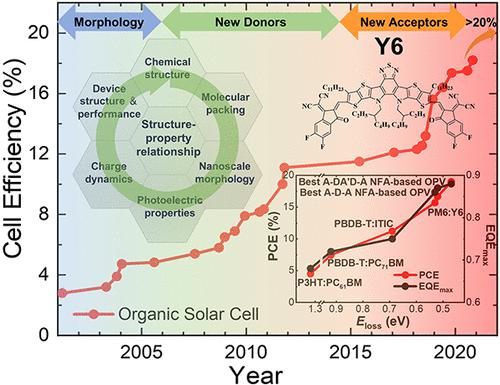当前位置:
X-MOL 学术
›
Chem. Rev.
›
论文详情
Our official English website, www.x-mol.net, welcomes your
feedback! (Note: you will need to create a separate account there.)
Renewed Prospects for Organic Photovoltaics
Chemical Reviews ( IF 51.4 ) Pub Date : 2022-08-05 , DOI: 10.1021/acs.chemrev.1c00955 Guichuan Zhang 1, 2 , Francis R Lin 3, 4 , Feng Qi 3, 4 , Thomas Heumüller 5, 6 , Andreas Distler 5 , Hans-Joachim Egelhaaf 5, 6 , Ning Li 1 , Philip C Y Chow 7 , Christoph J Brabec 5, 6 , Alex K-Y Jen 3, 4, 8, 9 , Hin-Lap Yip 1, 3, 8, 9
Chemical Reviews ( IF 51.4 ) Pub Date : 2022-08-05 , DOI: 10.1021/acs.chemrev.1c00955 Guichuan Zhang 1, 2 , Francis R Lin 3, 4 , Feng Qi 3, 4 , Thomas Heumüller 5, 6 , Andreas Distler 5 , Hans-Joachim Egelhaaf 5, 6 , Ning Li 1 , Philip C Y Chow 7 , Christoph J Brabec 5, 6 , Alex K-Y Jen 3, 4, 8, 9 , Hin-Lap Yip 1, 3, 8, 9
Affiliation

|
Organic photovoltaics (OPVs) have progressed steadily through three stages of photoactive materials development: (i) use of poly(3-hexylthiophene) and fullerene-based acceptors (FAs) for optimizing bulk heterojunctions; (ii) development of new donors to better match with FAs; (iii) development of non-fullerene acceptors (NFAs). The development and application of NFAs with an A–D–A configuration (where A = acceptor and D = donor) has enabled devices to have efficient charge generation and small energy losses (Eloss < 0.6 eV), resulting in substantially higher power conversion efficiencies (PCEs) than FA-based devices. The discovery of Y6-type acceptors (Y6 = 2,2′-((2Z,2′Z)-((12,13-bis(2-ethylhexyl)-3,9-diundecyl-12,13-dihydro-[1,2,5]-thiadiazolo[3,4-e]-thieno[2″,3″:4′,5′]thieno-[2′,3′:4,5]pyrrolo-[3,2-g]thieno-[2′,3′:4,5]thieno-[3,2-b]indole-2,10-diyl)bis(methanylylidene))bis(5,6-difluoro-3-oxo-2,3-dihydro-1H-indene-2,1-diylidene))dimalononitrile) with an A–DA′ D–A configuration has further propelled the PCEs to go beyond 15% due to smaller Eloss values (∼0.5 eV) and higher external quantum efficiencies. Subsequently, the PCEs of Y6-series single-junction devices have increased to >19% and may soon approach 20%. This review provides an update of recent progress of OPV in the following aspects: developments of novel NFAs and donors, understanding of the structure–property relationships and underlying mechanisms of state-of-the-art OPVs, and tasks underpinning the commercialization of OPVs, such as device stability, module development, potential applications, and high-throughput manufacturing. Finally, an outlook and prospects section summarizes the remaining challenges for the further development of OPV technology.
中文翻译:

有机光伏的新前景
有机光伏(OPV)通过光活性材料开发的三个阶段稳步发展:(i)使用聚(3-己基噻吩)和基于富勒烯的受体(FA)来优化本体异质结;(ii) 开发新的捐助者以更好地与 FA 相匹配;(iii) 非富勒烯受体 (NFA) 的开发。具有 A-D-A 配置(其中 A = 受体,D = 供体)的 NFA 的开发和应用使器件能够高效地产生电荷和较小的能量损失(E loss < 0.6 eV),从而显着提高功率转换效率 (PCE) 高于基于 FA 的设备。Y6型受体的发现(Y6 = 2,2′-((2 Z , 2′Z)-((12,13-双(2-乙基己基)-3,9-二十一烷基-12,13-二氢-[1,2,5]-噻二唑并[3,4- e ]-噻吩并[2″,3 ″:4′,5′]噻吩-[2′,3′:4,5]吡咯并-[3,2- g ]噻吩-[2′,3′:4,5]噻吩-[3,2- b ]indole-2,10-diyl)bis(methanylylidene))bis(5,6-difluoro-3-oxo-2,3-dihydro-1 H -indene-2,1-diylidene))dimalononitrile) 与 A -DA' D-A 配置进一步推动 PCE 超过 15%,因为E损失更小值(~0.5 eV)和更高的外部量子效率。随后,Y6 系列单结器件的 PCE 已增加到 >19%,并可能很快接近 20%。本综述提供了 OPV 在以下方面的最新进展:新型 NFA 和供体的发展,对最先进 OPV 的结构-性质关系和潜在机制的理解,以及支撑 OPV 商业化的任务,例如器件稳定性、模块开发、潜在应用和高通量制造。最后,展望和前景部分总结了 OPV 技术进一步发展的剩余挑战。
更新日期:2022-08-05
中文翻译:

有机光伏的新前景
有机光伏(OPV)通过光活性材料开发的三个阶段稳步发展:(i)使用聚(3-己基噻吩)和基于富勒烯的受体(FA)来优化本体异质结;(ii) 开发新的捐助者以更好地与 FA 相匹配;(iii) 非富勒烯受体 (NFA) 的开发。具有 A-D-A 配置(其中 A = 受体,D = 供体)的 NFA 的开发和应用使器件能够高效地产生电荷和较小的能量损失(E loss < 0.6 eV),从而显着提高功率转换效率 (PCE) 高于基于 FA 的设备。Y6型受体的发现(Y6 = 2,2′-((2 Z , 2′Z)-((12,13-双(2-乙基己基)-3,9-二十一烷基-12,13-二氢-[1,2,5]-噻二唑并[3,4- e ]-噻吩并[2″,3 ″:4′,5′]噻吩-[2′,3′:4,5]吡咯并-[3,2- g ]噻吩-[2′,3′:4,5]噻吩-[3,2- b ]indole-2,10-diyl)bis(methanylylidene))bis(5,6-difluoro-3-oxo-2,3-dihydro-1 H -indene-2,1-diylidene))dimalononitrile) 与 A -DA' D-A 配置进一步推动 PCE 超过 15%,因为E损失更小值(~0.5 eV)和更高的外部量子效率。随后,Y6 系列单结器件的 PCE 已增加到 >19%,并可能很快接近 20%。本综述提供了 OPV 在以下方面的最新进展:新型 NFA 和供体的发展,对最先进 OPV 的结构-性质关系和潜在机制的理解,以及支撑 OPV 商业化的任务,例如器件稳定性、模块开发、潜在应用和高通量制造。最后,展望和前景部分总结了 OPV 技术进一步发展的剩余挑战。











































 京公网安备 11010802027423号
京公网安备 11010802027423号